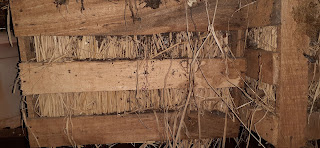Science behind Aerobic Composting:
If you maintain proper C:N ratio, provide lots of aeration, maintain the moisture in your compost, then microorganism will do the rest job.
What
is C:N ratio?
C-Carbon- Dead leaves, Saw dust, Coco-pith, egg shells, bones, teabags, tea powder, your old compost soil will act as source of carbon.
N-Nitrogen- Unwanted parts of uncooked green vegetable, leftover food, cuttings from your terrace garden, fruit scrape and skins are the sources of nitrogen.
What is proper C:N ratio?- 25to30:1
Remember A.T.S.M-
- Maintain Proper Aeration,
- Monitor Temp- it raises up in composting process upto 60 deg. then temp falls back when manure is ready.
- Keep your compost bin in Shed, Microbes are photo-phobic, They like dark places.
- Maintain Moisture not too wet/ Not too dry.
Wet compost will lead to Rotting Process.
If it is too dry decomposition will not happen. As microbes needs little moisture and oxygen to live.
Apply Sandwich Method:
Don’t forget to do C:N layering : Just spread your unwanted veggies/leftover food (Nitrogen) evenly to form 1 inch layer, then cover it with thick 2/3 inch layer of Carbon resources (anything which is available with you like saw dust,coco pith, old dried compost manure, soil, leaf litter, ash, etc). And do not disturb it till 15 days. After approximately 15 days your manure will be ready.
If you
follow these simple tricks we won’t need any culture or de-composters. I am
doing composting by this method since 4 years.
My Compost bin with zero set-up and maintenance cost:
I am doing composting in mango baskets and in carton boxes since 4 years now. which didn't cost a single penny to me.
Compost bin requires lots of aeration, so I have made plenty of holes to my carton box simply by pocking pointed tool. and these carton boxes has lasted for 4 years now without any complaints. My mango wooden box has hay lining which gives lots of aeration to compost.
For carbon I use my old dried compost. and do the C:N layering.
I don't use any kind of culture, decomposters, enzhym or Jivamrut or cow dung.
Black soldier fly:
I have seen this beetle entering in my compost..
Protaetia aurichalcea
But they good guys, they never come out of their home i.e. The compost bins
F.A.Q:
1. What should I do if observe fungi in my compost?
There are many types of Fungi, and 90% of them are not dangerous in fact they are part of a diverse community of “decomposters” that helps break down dead plants and veg/non. veg food waste.
2. I have Insects in my compost?
Composting process may invite lot of biodiversity, which will turn your compost in living soil. Microscopic bacteria, ants, small flies, maggots, larvae of black solder fly, white grubs etc..They will come to serve you and to convert your food waste into nice fertile soil and when the process is over they will leave your place or won't come out of compost bin for sure.
3. My compost has very bad smell?
Nothing to worry about! It’s due to excessive water which has lead to rotting process instead of decomposition. Please add some carbon. i.e. saw dust, old dried compost manure, soil to maintain proper moisture give some time and see the magic. :-)
Ref:
· Inora- www.inoraindia.com Contact- Veena Godbole.- 9637575945.
o You can get Earth worms, Inora composting starting mix, herbal pestisides in their shop at Bavdhan.
· Daily Dump: www.dailydump.org you can get lots of innovative products in composting.
· Sheti udyog Mandal, Swargate:
o You can get cocopith, different cultures, neem pend and garden tools at affordable price.
· Soil Circuit: https://www.facebook.com/soilcircuit/ Contact-Priya Bhide
o They conduct workshops on composting and terrace gardening at Deccan, Pune.
· Culture:
o Cow dung slurry, Jeevamrut is best culture.
o Microorganism culture by Innora India
o Culture by Sheti Udyog Mandal.
· Pest Control:
o When your compost is ready to use for plantation you can add neem pend as a Organic pesticide to your compost.
· Aerated Containers/bins:
o You can use any old plastic bin,bucket,colour bins with lots of hole on it.
o Bamboo basket- bhurud aali
o Plastic crates – Market yard or from vegetable shop owners.
o Any carton box available at your home (add plenty holes).
o Nylon bag with zip











Comments
Post a Comment